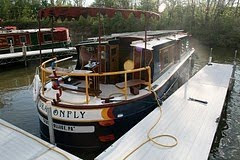Thursday night, in Pengallie Bay, a woman asked
where we were headed next. “Pointe au Baril,” I said, giving it the
French pronunciation, Pwanht oh bah-reel. “That’s Point o’ Barrel.”
she said, a bit sharply. (We’ve detected a bit of anti-French sentiment in some
of the folks we meet).
The English pronunciation does point out where the
town got its name. It was a fishing settlement in the late 1800s, and
villagers made a kind of primitive lighthouse on a rocky point, from a barrel
topped with a lantern.
The point has a real lighthouse today--and a
replica barrel (at left). The waters are not quite so tricky to navigate in the
21st century as they were in 1920, when a buoytender—the boat that goes out in
the spring, amid the ice chunks, to PLACE those helpful buoys—went down with
all hands.
 |
| These days Pointe au Baril has a real lighthouse |
These days there are far more detailed charts
to show you the route, and there's also GPS to confirm that you’re
ON the right route.
Still, our run from Pointe au Baril to Byng Inlet
was a challenging bit of piloting. It’s the water equivalent of hiking a
narrow footpath along the edge of a canyon, where if you put one foot wrong you
plunge off a cliff. The guidebook says, over and over, “Even in very deep
water, if you stray off the track by just a few feet, you could wind up on a
rock.”
 |
| The shore was THIS close! |
 |
| Passengers on boat should not look left or right, either! |
And we did, thought it was a queasy feeling to see
the shore so close in a boat so big. The water here is very clear, so
it’s actually easy to see the rocks . . . once you are right on top of them.
(The guidebook also advises, “Passengers on the boat who are nervous should not
look down.”)
We also navigated Hangdog Channel, which the
guidebook says “could well be the most exciting part of your trip,” adding,
“It’s easy to become confused.” Needless to say, the channel is narrow
and rocky, with the added element of with hairpin turns. There are plenty of buoys—and on this
stretch the rule is, “Keep the red buoys on your right, green buoys on the
left." And if you see a red buoy and a green buoy side by side, go right down the middle; they're the water equivalent of yellow lines down the edge of the road.
The challenge is, sometimes there’s a whole bunch
of buoys to guide you through a turn—a regular little bobbing jungle of red and
green sticks--and
from a distance it’s not entirely clear which two buoys make the pair you
should slide between first, or at what angle you should attack the turn. Sometimes you can’t quite tell even when you are right on top of the buoys.
A couple times yesterday we approached a field of buoys, stopped, checked the charts, and backed up to figure it all out.
And a couple times we contemplated a buoy field and looked at each other and said, “No way our boat is supposed to go through THAT space at THAT angle!" But we checked the charts and the GPS and—Yes-way, that was what we were supposed to do Having two pairs of eyes definitely helped. We traded off all day, one person steering, eyes on the water, while the other had eyes on the charts.
And a couple times we contemplated a buoy field and looked at each other and said, “No way our boat is supposed to go through THAT space at THAT angle!" But we checked the charts and the GPS and—Yes-way, that was what we were supposed to do Having two pairs of eyes definitely helped. We traded off all day, one person steering, eyes on the water, while the other had eyes on the charts.
Early on in our trip, back in Mexico, New York (on
the shores of Lake Ontario). we met a guy named Fran Talaber, who had boated
the Trent-Severn and these waters. He was so excited on our behalf about
our adventure, he ran home to fetch maps and books for us. He also spent a good
chunk of an afternoon taking us through the route.
“This part can be tricky,” he’d tell us, or “This
part’s really narrow,” and “Now here’s the part where this couple of boaters
trashed their propeller going out . . . and then trashed it again coming
back.”
But each time he repeated this advice. “Stay where
you’re supposed to be, and you’ll do fine!” Fran must have said this a
hundred times that afternoon.
“Nope, stay where you’re s’pozed to be . . . and you’ll do fine!”






Good Job! Always stay where your s'pozed to be! Good advice, I'd say.
ReplyDelete